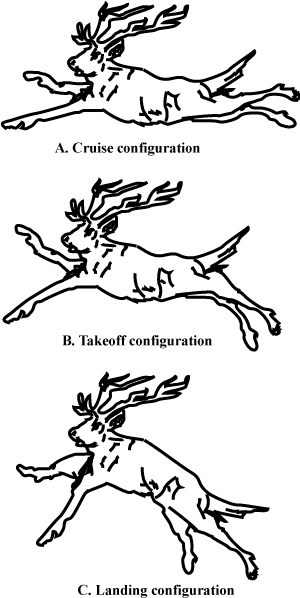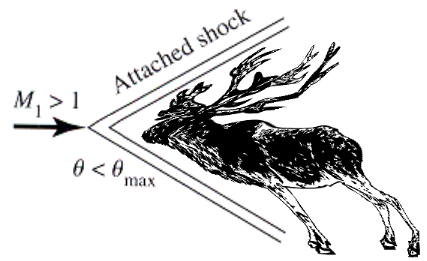Fundamentals of Reindeer Aerodynamics
 Fig. 1 Airfoil configuration for reindeer showing leading-edge
and trailing-edge high-lift mechanisms. During takeoff and landing,
the fore and hind limbs are fully deployed. Because the local air flow
through the multi-element limb and antler structures is locally
attached to the top surface, the lift coefficient is exceptionally high.
Fig. 1 Airfoil configuration for reindeer showing leading-edge
and trailing-edge high-lift mechanisms. During takeoff and landing,
the fore and hind limbs are fully deployed. Because the local air flow
through the multi-element limb and antler structures is locally
attached to the top surface, the lift coefficient is exceptionally high.
 he question of how reindeer can fly has puzzled researchers for many years.
The first well-documented encounter with a flying reindeer was in 1928, when
the New Jersey-born aviator Franky "Bubbles" Bibbliani was struck by a reindeer
over the Atlantic Ocean while attempting to repeat Lindbergh's famous flight
from Long Island, New York to Paris, France. After getting caught in a cross-wind,
Bibbliani's biplane drifted across the Arctic Circle where he experienced what
can only be described as an attack by a flock of rampaging reindeer:
he question of how reindeer can fly has puzzled researchers for many years.
The first well-documented encounter with a flying reindeer was in 1928, when
the New Jersey-born aviator Franky "Bubbles" Bibbliani was struck by a reindeer
over the Atlantic Ocean while attempting to repeat Lindbergh's famous flight
from Long Island, New York to Paris, France. After getting caught in a cross-wind,
Bibbliani's biplane drifted across the Arctic Circle where he experienced what
can only be described as an attack by a flock of rampaging reindeer:
"No matter how I turned, I was unable to avoide these flying beastes. Their dorsall finnes sliced gracefully through the air. They flew at me, antlers first, their bared teethe glistening in the moonlight and emitting the most bone-chilling screeching and snorting sound I have never before or since hearde. I dove toward the surface, the wind screaming through my propellers until I attained the breakneck speed of more than 50 knottes and I was sore afraide my propeller would breake. Yet they continued their pursuite. A blinding red wave of heate was emitted from their nose. My only defense was a half-empty bottle of Cutty Sark, three empty bottles of Smirnoff, and my supplie of tincture of cocaine, nearly depleted and gone off-color, which I threw at them. Finally I made my escape and headed forthwith to the safety of Greenlande whereupon I immediately headed for the nearest barr so that I might forgette these horrible creatures."
In his autobiography, Bibbliani goes on to describe the reindeer as "bright pink with large yellow spots," having six-inch fangs, and saying things like, "For great justice!" and "You have no chance to survive, make your time!" Although these and other details of this account, including Bibbliani's later account of blue lightning bolts shooting from the antlers, are admittedly puzzling, the phenomenon of airborne reindeer has been repeatedly confirmed by other observers with credentials as impeccable as those of Dr. Bibbliani, as well as by radar trackings by the militaries of several countries, including Canada, Finland, and Greenland. Yet these reports have been almost universally received with amused skepticism by the scientific community.
Some scholars have disputed Bibbliani's account, noting that reindeer are generally peaceful and never shoot lightning bolts from their antlers or any other part of their body, except in rare instances. It has therefore been speculated that this particular flock may have been afflicted with reindeer rabies. The yellow spots might be indicative of Rocky Mountain spotted fever; however, it should be noted that this disease has rarely been observed in reindeer.
We may take solace, however, in recalling that these are the same skeptics who calculated way back in 1962 that Peugeots likewise could not fly. Yet we have only to watch any number of drug-smuggler movies to realize that all French cars, including Peugeots, Renaults, and even Citroëns, are quite capable of short bursts of airborne flight. This is all the more remarkable when one realizes that a Citroën is only able to reach highway speeds on the ground when on a downward slope exceeding 45 degrees. Thus, we may safely dismiss these skeptics as flying reindeer deniers.
It has often been noted with some amusement that Bibbliani's luggage, like Lindbergh's, was found to be missing after the flight. Some have speculated that, indeed, his luggage, not Bibbliani himself, was the reindeer's real target. Dr Bibbliani was known to have packed several kilograms of rock salt, which deer crave, in his suitcase. However, as amusing as it may be for us, the reindeer incident only resulted in tragedy for Dr Bibbliani. His reputation crushed by publicity about his reports of pink spotted flying reindeer, Bibbliani later moved to Italy, where he joined Mussolini's Fascist party.
How did reindeer evolve flight?
We are thus entitled to ask, how is the reindeer able to fly? Given that the reindeer's torso is a heavier than air body with no wings and no recognizable means of producing thrust, it is a challenging question indeed. Yet, like birds, reindeer migrate. No creature could possibly be stupid enough to try to walk for thousands of miles through three-foot-deep snow. Therefore, reindeer must, somehow, be able to fly.
"Reindeer keep falling on my head!" --B. J. ThomasIndeed, paleontologists believe that reindeer were originally arboreal creatures, like the birds of today. In the distant past, reindeer would try to swoop down from the trees to capture small prey animals such as mice. Unfortunately, since they lacked wings and feathers, the first several million reindeer to try this simply smashed into the ground--unfortunate, perhaps, for them, but fortunate for paleontologists, because it created for us a rich if somewhat mangled fossil record. Indeed, the earliest reindeer fossils gave a misleading picture of the animal's shape, and early reconstructions of proto-reindeer sometimes showed a unique morphology, with the head and antlers smooshed together and attached to the chest cavity, with the four limbs spread out in a perfect X-shape. Later fossils show that reindeer gradually learned to use what is referred to as the "belly flop" or "belly smacker" and were able to land up to two feet away from the tree trunk, indicating an angle of impact of two or even in some cases three degrees. Gradually, using the tremendous power of a mystical technique known as "positive thinking," reindeer evolved the powerful magical levitation technique that they use today.
Some researchers point to the tree-branch-like antlers of reindeer as evidence of a symbiotic relationship between reindeer and their arboreal hosts. They suggest that the cells of reindeer, like some species of bacteria, are able to exchange DNA with other cells, and their antlers are the result of osmosis of tree DNA into the deer's genome. Given that these trees were also undoubtedly full of birds, it is even possible, these scholars say, that the deer could also have absorbed avian DNA molecules and thereby gained the power of flight. They suggested, for example, that their large ears may act as wings and the antlers served as stabilizing fins.
On the Aerodynamics of Flying Ungulates
 Fig. 2 When a reindeer's velocity exceeds Mach 1, it will create a shock
wave. The nose deflection angle θ has a maximum value θmax,
above which no straight shockwave can exist. Instead, a curved shockwave is found
that is detached from the animal's body. If the reindeer's nose is too pointy,
the shockwave is straight and is attached to the animal's nose. In extreme cases,
this can create nasal congestion, inflammation, and reddening.
Fig. 2 When a reindeer's velocity exceeds Mach 1, it will create a shock
wave. The nose deflection angle θ has a maximum value θmax,
above which no straight shockwave can exist. Instead, a curved shockwave is found
that is detached from the animal's body. If the reindeer's nose is too pointy,
the shockwave is straight and is attached to the animal's nose. In extreme cases,
this can create nasal congestion, inflammation, and reddening.
Aviation engineers, however, vehemently dispute this theory, pointing out that the ears of a reindeer are inherently un-aerodynamic, and would have to flap over 36,700 times per minute to produce enough lift to raise a reindeer off the ground. Similarly, even though the reindeer's trunk is unquestionably a lifting body, it too has a distinctly un-aerodynamic shape. Ornithologists ridicule the idea that a reindeer could fly using conventional means, because it is totally lacking in feathers and, of course, lacks wings.
As a result, the idea that reindeer can fly by "positive thinking" has by default become the dominant theory, and it has become the general consensus that anyone skeptical about this theory should be categorized as a Positive Thinking Denier and shunned by all correct-thinking World Citizens. Accordingly, the positive thinkers have pressured scientific journals to prevent these negative-thinking ignoramuses from publishing any results that might tend to disprove their theory, and pressured university administrators to fire from their jobs anyone foolish enough to try. They also issued a joint summary statement from the highly respected United Nations Intergovernmental Panel on Reindeer Change (IPRC) stating that
"All our friends believe this theory and those who don't are a bunch of reactionary dummies, so there!"
In response, a group of 35,000 so-called reindeer change deniers signed a petition which was remarkable in its simplicity, consisting of only five words:
"We are not, so there!"
So, given this background of high-level sophisticated intellectual and
scholarly debate on the subject, what are we to conclude about how reindeer
fly? There is some doubt about whether the positive thinking alone is capable
of generating sufficient kinetic energy to lift a reindeer. Unfortunately, it
will remain a mystery, and this writer is unable to
finish this article because I have just been fi
'oufff
hi got im
